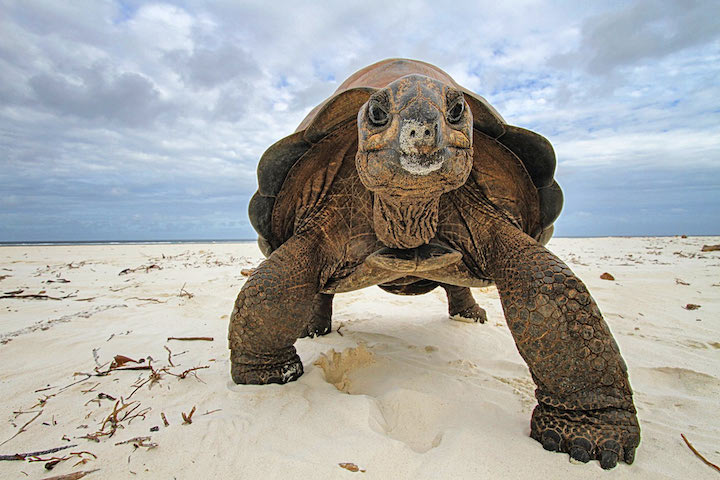

Aldabra Atoll in the Indian Ocean is one of the largest raised coral reefs in the world. This atoll, consisting of coral islands ringing a shallow lagoon, is known for the hundreds of endemic species—including the Aldabra giant tortoise—that live there. According to UNESCO, Aldabra contains “one of the most important natural habitats for studying evolutionary and ecological processes.”
Located more than 400 kilometers (250 miles) northwest of Madagascar and more than 600 kilometers (375 miles) east of mainland Africa, Aldabra is one of the coralline outer islands of the Seychelles. The OLI-2 (Operational Land Imager-2) on Landsat 9 captured this image of the remote atoll on June 24, 2022. Tides flow in and out of the lagoon through channels between the large perimeter islands. The land tops out at a mere 8 meters (26 feet) above sea level.
Due to the islands’ isolated location, rough terrain, and scarcity of fresh water, the human footprint on the atoll is relatively small. A research station on West Island (also called Picard Island) has operated since 1971, but tourism is limited and carefully controlled. Aldabra Atoll was designated a UNESCO World Heritage site in 1982 and a Ramsar site in 2009.
Though the atoll may be remote and rugged, it is not desolate. It contains a variety of habitats that have spurred the evolution of specially suited flora and fauna. The atoll’s varied habitats support many species, including the largest breeding population of frigatebirds in the Indian Ocean and one of only two oceanic flamingo populations in the world.
In one remarkable case, a bird species on Aldabra evolved to be flightless—twice. The islands have been completely underwater at least once in their history when global mean sea level was higher, wiping out all life on the atoll. The fossil record contains evidence of a flightless rail (a bird in the same family as coots and crakes) before the last submergence, and of a flying white-throated rail that evolved to live on the ground after the islands reemerged. With the lack of terrestrial predators and an abundance of food, the bird thrived without the ability to fly.
Seven different types of wetlands, including shallow marine waters and seagrass beds, exist at Aldabra. Mangrove forests line much of the lagoon-facing sides of the large islands. They provide nesting sites for wading birds, as well as feeding grounds for turtles, sharks, and other marine species.

On land, the mostly herbivorous Aldabra giant tortoise (above) sits atop the terrestrial food chain. The population of this social tortoise species is estimated to exceed 100,000. Males can weigh up to 250 kilograms (550 pounds) and measure 1.2 meters (4 feet) in length.
In 2018, a small group of Aldabra giant tortoises was reintroduced to neighboring Madagascar, where no giant tortoises had lived for 600 years due to overhunting. Ecologists believe the lumbering creatures could promote forest regeneration on cattle-grazed land by distributing seeds through their dung. They may also suppress fire risk by feeding on grasses and dry leaves.
NASA Earth Observatory image by Wanmei Liang, using Landsat data from the U.S. Geological Survey. Photograph by Dennis Hansen, University of Zurich. Story by Lindsey Doermann.